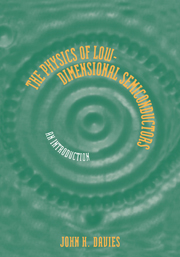Book contents
- Frontmatter
- Contents
- Preface
- Introduction
- 1 FOUNDATIONS
- 2 ELECTRONS AND PHONONS IN CRYSTALS
- 3 HETEROSTRUCTURES
- 4 QUANTUM WELLS AND LOW-DIMENSIONAL SYSTEMS
- 5 TUNNELLING TRANSPORT
- 6 ELECTRIC AND MAGNETIC FIELDS
- 7 APPROXIMATE METHODS
- 8 SCATTERING RATES: THE GOLDEN RULE
- 9 THE TWO-DIMENSIONAL ELECTRON GAS
- 10 OPTICAL PROPERTIES OF QUANTUM WELLS
- A1 TABLE OF PHYSICAL CONSTANTS
- A2 PROPERTIES OF IMPORTANT SEMICONDUCTORS
- A3 PROPERTIES OF GaAs–AlAs ALLOYS AT ROOM TEMPERATURE
- A4 HERMITE'S EQUATION: HARMONIC OSCILLATOR
- A5 AIRY FUNCTIONS: TRIANGULAR WELL
- A6 KRAMERS–KRONIG RELATIONS AND RESPONSE FUNCTIONS
- Bibliography
- Index
10 - OPTICAL PROPERTIES OF QUANTUM WELLS
Published online by Cambridge University Press: 05 June 2012
- Frontmatter
- Contents
- Preface
- Introduction
- 1 FOUNDATIONS
- 2 ELECTRONS AND PHONONS IN CRYSTALS
- 3 HETEROSTRUCTURES
- 4 QUANTUM WELLS AND LOW-DIMENSIONAL SYSTEMS
- 5 TUNNELLING TRANSPORT
- 6 ELECTRIC AND MAGNETIC FIELDS
- 7 APPROXIMATE METHODS
- 8 SCATTERING RATES: THE GOLDEN RULE
- 9 THE TWO-DIMENSIONAL ELECTRON GAS
- 10 OPTICAL PROPERTIES OF QUANTUM WELLS
- A1 TABLE OF PHYSICAL CONSTANTS
- A2 PROPERTIES OF IMPORTANT SEMICONDUCTORS
- A3 PROPERTIES OF GaAs–AlAs ALLOYS AT ROOM TEMPERATURE
- A4 HERMITE'S EQUATION: HARMONIC OSCILLATOR
- A5 AIRY FUNCTIONS: TRIANGULAR WELL
- A6 KRAMERS–KRONIG RELATIONS AND RESPONSE FUNCTIONS
- Bibliography
- Index
Summary
The optical properties of low-dimensional systems are put to wide practical use, the semiconductor laser being an obvious example. In this chapter we shall expand the general results derived in Chapter 8 and apply them to low-dimensional structures.
First, the general theory needs to be developed further. A surprising result is that the real and imaginary parts of the complex dielectric function or conductivity are not independent functions, but can be derived from one another. This relies on the principle of causality, that a response should follow its stimulus, embodied in the Kramers–Kronig relations. Other important results follow, such as the f-sum rule that controls the total absorption of a material integrated over all frequencies.
Although transport properties often rely on one kind of carrier alone, this is not true of optical processes. We must therefore treat the valence band of semiconductors in detail, a task that we have long postponed. We shall do this with the celebrated Kane model, an extension of the k · p theory developed earlier. We also need to consider the full wave function within the effective-mass approximation. Usually we neglect the Bloch part and study only the slowly varying envelope, but both must be included in the matrix elements and each makes a contribution to the selection rules. Quite different results emerge for transitions between bands and those within the same band.
- Type
- Chapter
- Information
- The Physics of Low-dimensional SemiconductorsAn Introduction, pp. 371 - 408Publisher: Cambridge University PressPrint publication year: 1997



